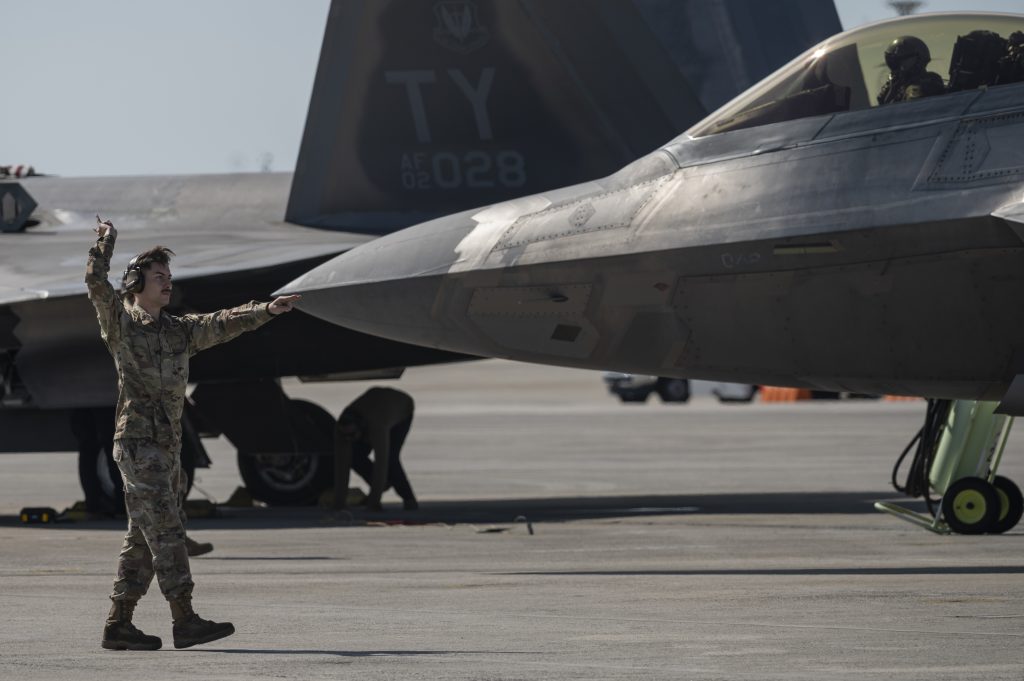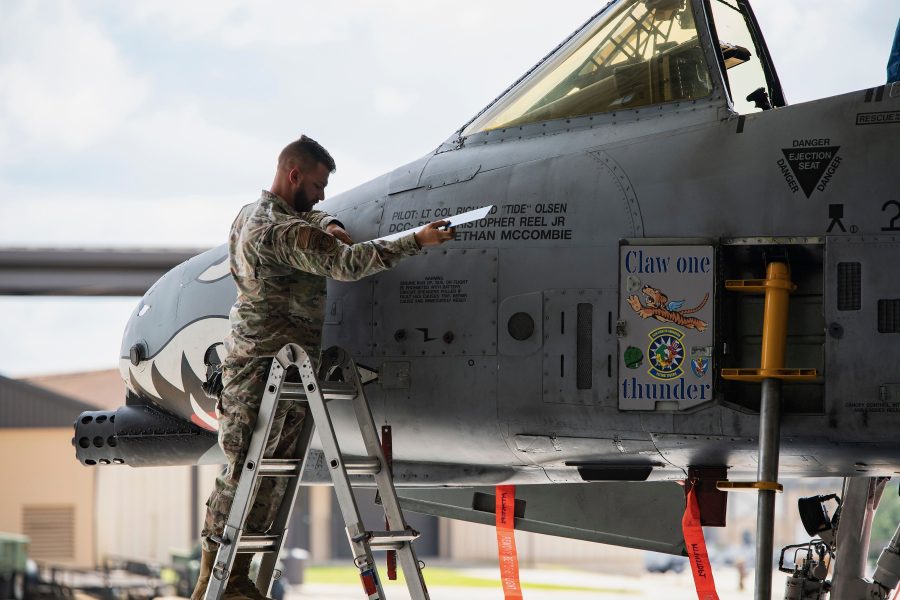The Air Force plans to shrink its total aircraft inventory in fiscal 2025, cutting its plans for new airframes while continuing to retire old platforms, the service revealed in its budget request, released on March 11. The Air Force plans to divest 250 aircraft in FY25, dropping its total aircraft inventory below 5,000, an unprecedentedly small number.
“We’re protecting the current force’s capabilities at what we think is an acceptable level of risk,” Secretary of the Air Force Frank Kendall told reporters ahead of the budget’s official release.
The 2025 budget predicts a total aircraft inventory of 4,903 aircraft, according to a service accounting of total aircraft inventory.
Fiscal Year 2025 Divestments
| Aircraft | Number of Airframes |
|---|---|
| F-22 | 32 |
| HH-60G | 12 |
| F-15C/D | 65 |
| A-10 | 56 |
| F-15E | 26 |
| F-16C/D | 11 |
| C-130H | 6 |
| EC-130H | 1 |
| CV-22 | 2 |
| E-11 | 1 |
| KC-135 | 16 |
| T-1 | 22 |
| TOTAL | 250 |
The Air Force is heavily focused on modernization, so protecting research and development comes at the cost of new aircraft purchases in the latest budget, according to top service officials. The aircraft divestment plan is worth over $2 billion in savings, deputy assistant secretary of the Air Force for budget Maj. Gen. Mike A. Greiner said.
“For the most part, our divestments were planned because we need to start moving the funding into the modernization programs,” Kristyn E. Jones, the acting undersecretary of the Air Force told reporters March 11.
The Air Force wants to purchase 42 F-35As and 18 F-15EXs—a total of 60 new fighters. That will not meet the service’s stated long-term goal of at least 72 new fighters annually. The Air Force is moving towards awarding the first contracts for Collaborative Combat Aircraft (CCAs), semi-autonomous aircraft that will accompany the manned fighter fleet. CCAs will “rethink our definition” of the USAF fighter fleet, Air Force Chief of Staff Gen. David W. Allvin said on March 7.
Fiscal Year 2025 Procurements
| Aircraft | Number of Airframes |
|---|---|
| F-35A | 42 |
| F-15EX | 18 |
| KC-46 | 15 |
| MH-139 | 8 |
| T-7A | 7 |
| C-40 | 1 |
| TOTAL | 91 |
“The numbers are going down in the near term,” said Jones. However, she said CCAs could change that calculus in the long term. “We are ramping that program up as much as we can—if we have [fiscal] ’24 appropriation, even faster—to try to get that affordable mass capability to mainly offset those divestments of our old fleet,” she said.
Jones said on March 11 that the decrease in the planned F-35 buy was due to budgetary constraints and delays in the fighter’s planned F-35 Technology Refresh-3 (TR-3), a significant but lagging software upgrade. However, the change does not mean the service is less committed to the F-35 in the long term, she said.
“Given the fiscal constraints this year, as well as the delays in getting the capabilities that we need, we re-phased the program, but we haven’t cut off the total numbers,” Jones said.
The service is seeking to ditch 65 aging F-15C/Ds, some of which are barely airworthy, and divest 56 A-10 Warthog aircraft, which the USAF wants to retire from the force entirely by 2029. The service also wants to get rid of 26 F-15E Strike Eagles with less powerful Pratt and Whitney F100-PW-220 engines but upgrade the portion of the fleet with more powerful engines with the Eagle Passive Active Warning and Survivability System (EPAWSS), which provides “an advanced digital electronic warfare system capable of defeating modern threat systems in contested airspace,” the service’s budget documents state.
Some of the Air Force’s retirement plans are controversial: leaders are once more trying to retire 32 of their oldest F-22s, which they argue are no longer viable in combat. Instead, they want to fund “investments in F-22 sensor enhancements to more closely track and stay ahead of potential adversaries,” according to the Department of the Air Force’s budget request.
“Block 20 airframes lack many of the enhanced capabilities of the Block 30/35 jets,” an Air Force spokesperson said of the rationale. “Upgrading them to Block 30/35 is not feasible due to cost and time constraints.”
Congress has long balked at the prospect of retiring any models of what many see as the world’s best air superiority fighter and passed legislation prohibiting any such retirements until fiscal 2028. However, the Air Force has held firm in its desire to retire the old Block 20 aircraft—reducing the F-22 fleet from 185 to 153 aircraft—for several years.
“We’ll comply with the law, obviously, but we’re putting those F-22s back on the table in order to fit in the other things we think are higher priority,” Kendall said
That includes the Next Generation Air Dominance (NGAD) platform, the replacement for the F-22, service officials say.

The F-15EX, a modernized version of the venerable fourth-generation fighter, has been in a state of flux for several years now. The service initially planned to purchase 144 as an advanced fourth-generation replacement for the old F-15C/Ds. But now the service says it will buy 18 more in 2025 then end production, capping the fleet at 98.
The Fiscal Responsibility Act, a 2023 law that capped the defense budget at a 1 percent rise, limited the service’s resources. The Department of Defense is also enacting a 4.5 percent pay raise for service members and a 2 percent pay raise for civilians, in addition to other benefits increases.
“We’re modernizing to the extent we can under the caps as the Federal Fiscal Responsibility Act,” Kendall said. “We’ve made some adjustments in procurement and we’re going to fund some additional modernization, research, and development, so that’s the overarching picture.”
A low-rate initial production of seven T-7A Red Hawk trainers is funded, which will help alleviate the aging T-38 fleet, which has been increasingly hard to maintain to keep training flying hours up, though the T-7 has faced significant delays. The Air Force also plans to procure 15 KC-46 Pegasus tankers to replace 16 1950s-era KC-135s it plans to divest in 2025. The service continues to move forward with its long-term plan to bring in the Next Generation Aerial Refueling System (NGAS), with investments in the program office to develop the future tanker. “We will work to define and finalize an acquisition strategy this year,” for NGAS, Greiner told reporters.
